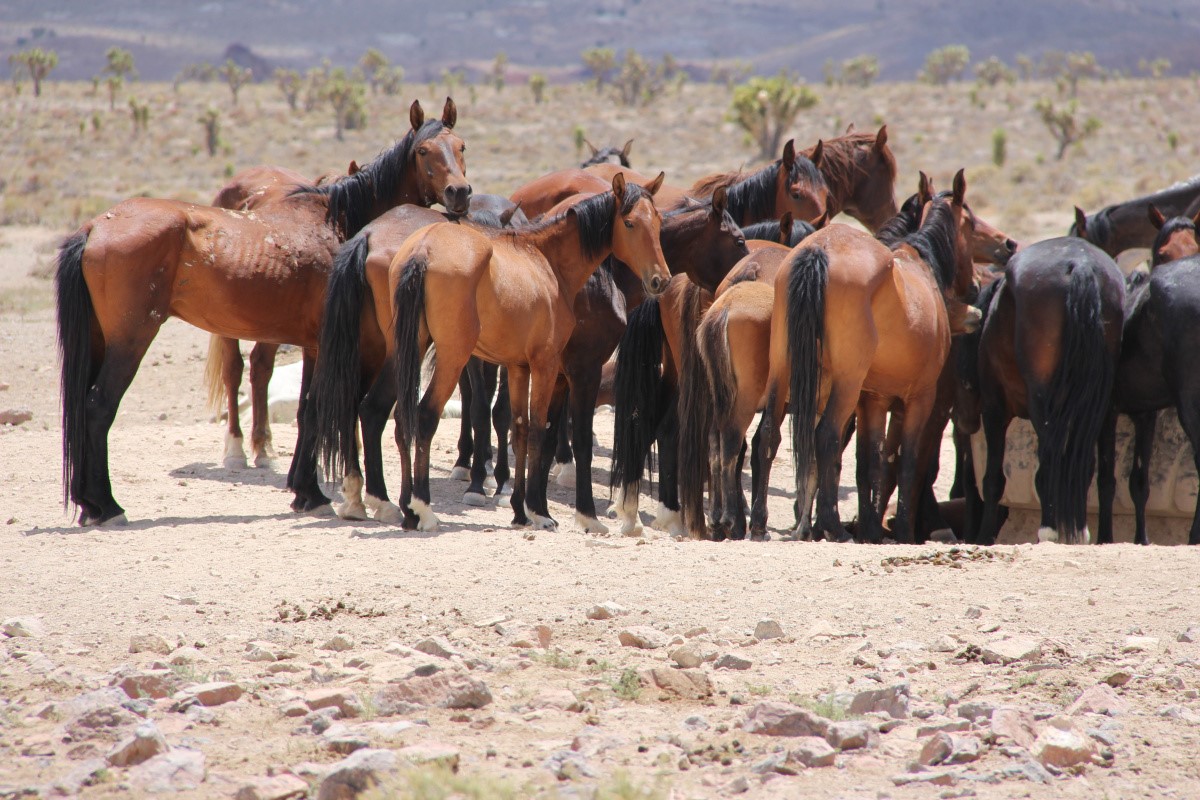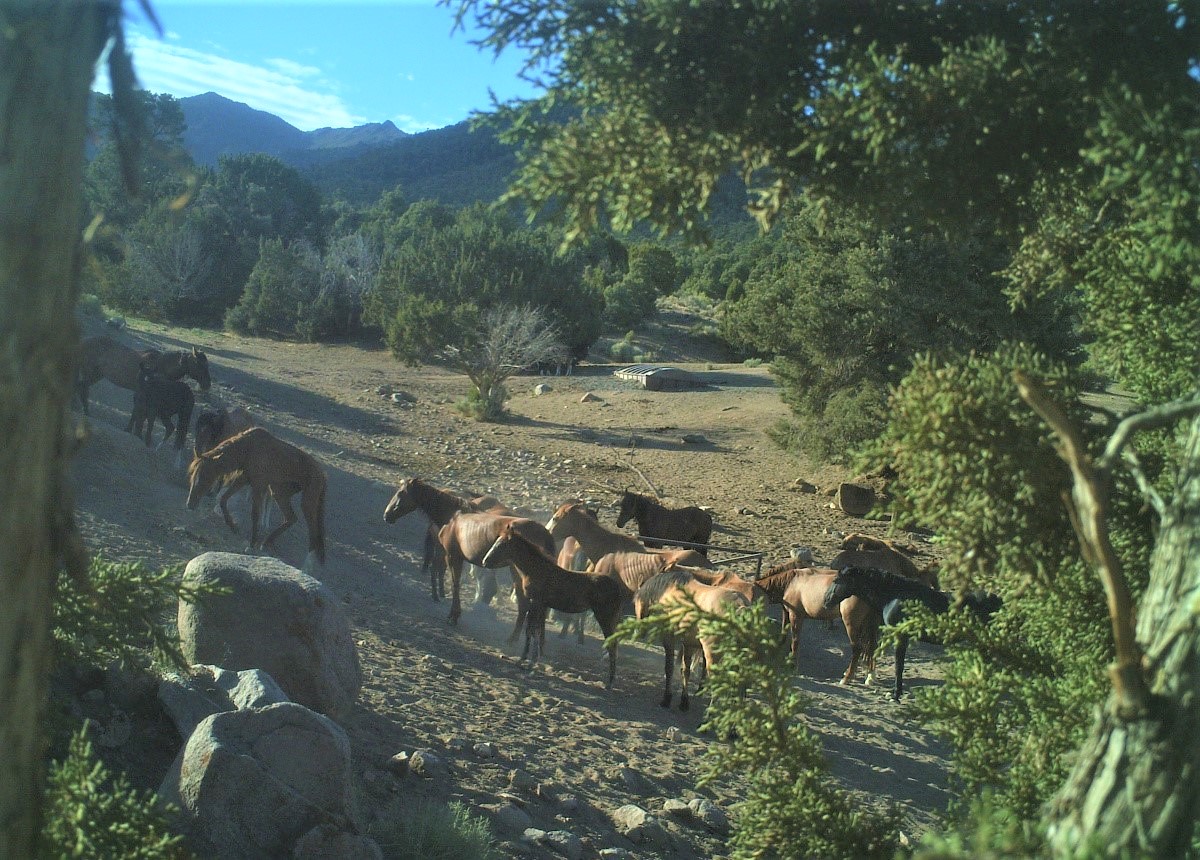You are viewing ARCHIVED content published online before January 20, 2025. Please note that this content is NOT UPDATED, and links may not work. Additionally, any previously issued diversity, equity, inclusion or gender-related guidance on this webpage should be considered rescinded. For current information, visit https://www.blm.gov/blog.
The BLM works to save wild horses and burros from thirst as overpopulated herds struggle to find enough water
As the summer dry season tightens its grip across the West, many wild horses and burros on public lands are finding it increasingly difficult to locate fresh water and forage. Nowhere is this more prevalent than in the state of Nevada, where the Bureau of Land Management has had to conduct emergency operations to save animal lives in herds that have, over the years, grown larger than what can be supported by the land.
So far this year, the BLM has conducted emergency gathers in six wild horse and burro herds across Nevada due to a lack of available water. UPDATE: As of August 28, the BLM has conducted or is in the process of conducting emergency gathers in eight wild horse and burro herds across Nevada and Utah due to a lack of available water this summer.
The wild horses of the Nevada Wild Horse Range, where the land is managed principally for their use, are no strangers to emergency operations. The most recent gather, which began in late July, follows a similar operation initiated in 2018 that gathered more than 800 animals that had little or no access to stable supplies of water. Though the animals roam one of the largest herd management areas in the state, the herd can grow rapidly – doubling in just four or five years – which puts a strain on the limited water available in the high desert terrain.

This year’s emergency operations in the Antelope Valley herd, which roams public lands in the eastern portion of the state, follow multiple years of similar emergencies as the BLM battles chronic overpopulation. The herd has in some recent years grown to as much as seven times the size that land managers and scientists say is sustainable. Constant overpopulation, they say, puts the animals at increasingly high risk, especially when drought occurs.
Deer Spring, for example, is an important source of water for wild horses and other wildlife in an area of the Antelope Valley Herd Management Area. The spring, however, routinely suffers from overuse and degradation as more and more animals attempt to access it. Despite attempts by BLM to improve the infrastructure and improve flow, the agency has had to act several times since 2015 to rescue animals that could not access enough water to survive.

Though many operations are still ongoing, nearly 1,000 animals are already planned to be gathered through emergency actions this year. With months of dry and hot conditions still remaining, there may be even more need for action before this year is through.
In addition to responding to emergency situations, the BLM is also focused on reducing overpopulation across the West to prevent conditions from developing that would require emergency action. The BLM estimated as of March 1, 2020 that a total of more than 95,000 wild horses and burros roam public lands in 10 Western states -- nearly four times the combined appropriate management level.
In Utah, for example, the BLM made significant progress towards achieving a healthy population size in a herd that was nearly nine times the size that was healthy for the animals and the land. The wild horses of the Swasey herd now number just a few hundred animals more than its target size, helping to ensure all animals have better access to enough food and water to keep them healthy throughout the year. Additional operations are planned to bring the herd to appropriate management level.
As part of its approach to managing wild horses and burros, the BLM also relies on the use of fertility control vaccines to slow growth in herds where it can be effective – typically smaller, more approachable herds where the animals can be more readily accessed and tracked. Recently the BLM has begun using a new vaccine that can cause up to 5 years of contraception if boostered correctly. With the help of partners and volunteers, the BLM supports remote darting efforts in twelve herds across the West, and has incorporated fertility control treatments in six gather operations so far this year in Idaho, Nevada, Oregon and Utah.
The BLM is eager to work with Congress and the agency’s partners to ultimately achieve a healthy and sustainable wild horse and burro population across the West and prevent more emergency situations from occurring. To that end, the BLM recently submitted a report to Congress detailing a plan to achieve appropriate management levels over 15-18 years. The plan relies on a combination of gathers, adoptions, more low-cost and long-term holding, and expanded use of fertility control to stabilize herds at their appropriate levels.
Without an all-of-the-above approach and further action, the Report explains, the wild horse and burro population on public lands could reach nearly 3 million by 2040. A population of that size would cause catastrophic harm to America’s system of public lands and the hundreds of species of wildlife that call it home, to the permitted activities that support local economies across the West, and to the health of the wild horses and burros themselves.
DOWNLOAD the 2020 Wild Horse and Burro Report to Congress and Fact Sheet
Are you a horse owner, or potential horse owner, who wants to be part of the solution? The BLM offers wild horses and burros for adoption and sale to qualified homes at facilities and events across the country. Visit our event schedule to find your next opportunity to bring home a living legend. Act now to adopt an untrained animal and you will be eligible to receive up to $1,000 through the Adoption Incentive Program.
Related Content
Related Stories
- Progress on Public Lands: BLM 2025 Trump Administration Accomplishments | January 20 - December 31, 2025
- Popular posts: BLM's most viewed blogs of 2025
- Using science to uncover mysteries of the Mesa archaeological site in Alaska
- “Where did my horse come from?” BLM launches a new way for adopters, trainers and others to learn about their wild horses and burros
- Lake Havasu Fisheries Improvement Program is the gift that keeps giving
